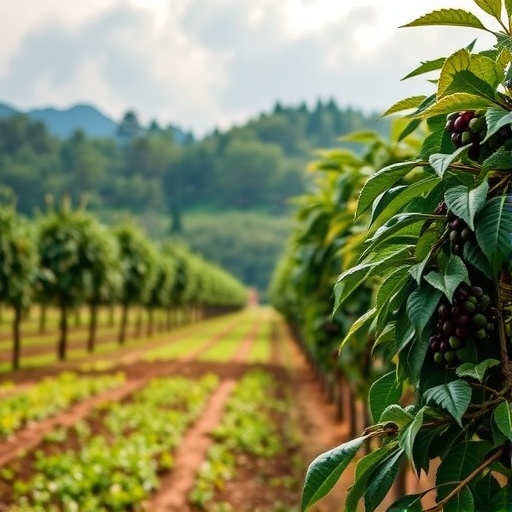A recent groundbreaking study published in Environmental Research Letters presents a nuanced perspective on the viability of climate intervention strategies to safeguard economically and culturally significant luxury crops such as wine grapes, coffee, and cacao. These crops not only contribute substantially to global agricultural economies but also underpin the livelihoods of millions of farmers around the world. However, they are increasingly threatened by the intensifying impacts of climate change, with warming temperatures and altered precipitation patterns causing erratic fluctuations in crop yields. Such instability poses a dire challenge for producers who depend on predictable agricultural outcomes for income and sustainability.
The research focuses on Stratospheric Aerosol Injection (SAI) as a potential geoengineering method aimed at mitigating some of the adverse climatic effects jeopardizing these crops’ future. SAI involves the deliberate release of reflective aerosols into the stratosphere to mimic the cooling aftermath of volcanic eruptions, thereby potentially lowering global surface temperatures. This study hones in on its application within the world’s premier grape, coffee, and cacao cultivation zones, located primarily in western Europe, South America, and West Africa, evaluating its capacity to stabilize the macroclimate during the projected span of 2036 to 2045.
Utilizing advanced climate modeling and simulations across eighteen major crop-producing regions, the researchers undertook a detailed assessment of environmental factors critical to crop viability. These include mean temperatures, precipitation volumes, as well as humidity and disease prevalence risks. Despite the cooling effect of SAI observed across these territories, the findings reveal a sobering limitation: only six of the eighteen regions showed consistent climate improvements conducive to maintaining existing agricultural suitability under SAI scenarios when compared with a baseline scenario lacking SAI intervention.
One of the key insights from this investigation is that temperature amelioration alone is insufficient to shield these sensitive crops. While SAI effectively curtails some of the thermal stresses associated with climate change, it cannot reliably stabilize precipitation patterns or curb relative humidity fluctuations, which are pivotal variables influencing yield outcomes. This unpredictability in rainfall and moisture levels directly impacts pest and pathogen dynamics, which can devastate crop health, particularly in luxury crops that possess specific ecological sensitivities.
In-depth analysis of cacao’s response under SAI intervention sheds light on this complexity. Although cacao is generally more resilient to elevated heat compared to grapevines and coffee plants, it is nevertheless highly vulnerable to an interplay of climatic factors—especially humidity and disease pressure—that fluctuate significantly even if temperature stresses are lessened. The inability of SAI to mitigate these environmental variabilities means the risk of pest outbreaks and diseases remains high, threatening both yield stability and farmer livelihoods.
Dr. Ariel Morrison, co-author of the study, points out the multifaceted challenges faced in relying solely on climate geoengineering as a protective measure. She emphasizes the importance of accounting for natural climate variability, which can induce a wide range of environmental conditions even within the same climate intervention framework. This variability complicates prediction and planning for farmers who rely on consistent weather patterns for planting, cultivation, and harvest schedules.
Moreover, the study underscores that while SAI might offer some temporary regional temperature relief, this benefit must be contextualized within broader ecosystem responses that remain insufficiently controlled by aerosol injection techniques. Such incomplete intervention risks producing scenarios where some regions may benefit mildly, while others continue to experience pronounced agricultural disruptions, hence compounding the challenges for global luxury crop markets and their associated agrarian communities.
A key takeaway from this research is the critical need for adaptive strategies tailored to local agroecological contexts. Investment in resilient agricultural practices, including integrated pest management, drought-resistant crop variants, and soil health optimization, is more essential than ever. Equally, the study highlights that achieving any meaningful and sustainable protection for these crops requires coordinated global cooperation that integrates climate mitigation, geoengineering research, and adaptive farming innovations.
While stratospheric aerosol injection represents a promising frontier in climate science, this study cautions against viewing it as a panacea. The complex interactions between temperature, precipitation, humidity, and pest dynamics illustrate that reducing global temperatures alone cannot assure the preservation of these luxury crops. The research calls for multi-dimensional approaches that combine scientific innovation with socio-economic and ecological resilience frameworks to address the compounded vulnerabilities experienced by the world’s most prized agricultural commodities.
This comprehensive study not only advances our understanding of the limitations surrounding SAI as a climate intervention but also draws critical attention to the broader implications for food security, economic stability, and cultural heritage embedded within these crops. Given the vital role that wine, coffee, and cacao play globally, the research provides a compelling argument for policymakers and stakeholders to diversify their climate adaptation strategies beyond reliance on technological fixes alone.
Ultimately, this investigation marks an important milestone in the dialogue around geoengineering applications in agriculture. It tempers enthusiasm surrounding stratospheric aerosol injection with scientifically grounded realism, advocating for more holistic and context-aware strategies that recognize the intricate dependencies of crop ecosystems on a suite of climatic and biological factors. As the climate crisis advances, the insights garnered here will be indispensable in guiding future interventions aimed at preserving the delicate balance necessary for luxury crop survival.
In summary, while SAI may offer a measure of mitigation against increasing temperatures, the unpredictable effects on rainfall and humidity diminish its effectiveness for securing the stable production of coffee, cacao, and grapes. The study calls for integrated approaches that encompass both climate intervention and adaptive agricultural management to foster resilience among these vulnerable crops and the communities they support.
Article Title: Macroclimate growing conditions for luxury crops after stratospheric aerosol injection
News Publication Date: 4-Nov-2025
Web References:
- https://iopscience.iop.org/article/10.1088/1748-9326/adfbff
- https://iopscience.iop.org/journal/1748-9326
Image Credits: IOP Publishing
Keywords: Climate change




